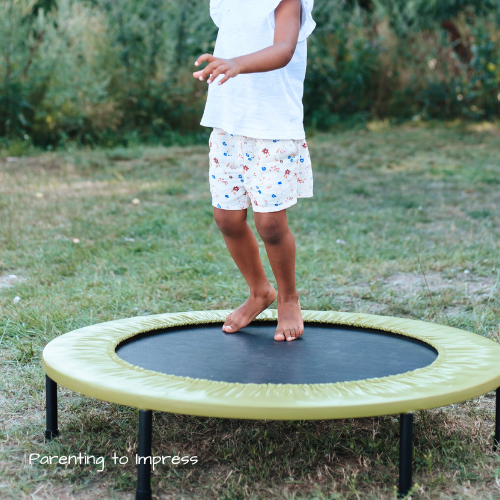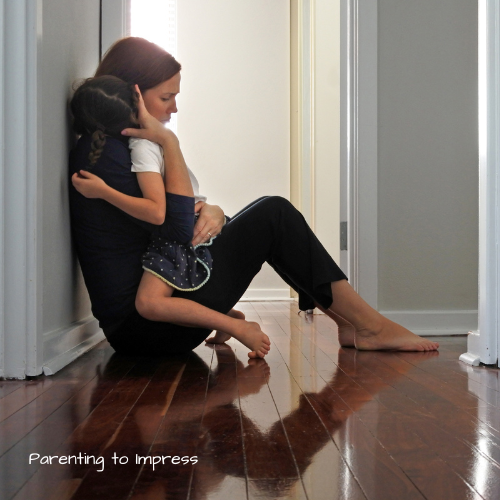Sharing a past post in the prayers that it will be helpful to many.
It was the perfect scenario—or so I thought.
We had just left church, and Grams was sitting in the backseat cuddling with Bubs (age seven). We picked up pizza and chatted about the fun day we had thus far with family. Once home, everyone gathered at the dinner table—except Bubs. Assuming he was still changing his clothes from church, I accepted Grams’ offer to check on him.

But the look on her face when she returned said it all.
For the first time, Bubs—who adores his Grams—had told her, “Leave me alone! I don’t want you!” Shocked, I went to his room trying to figure out what had gone wrong. It didn’t take long to recognize the signs: Bubs was in full meltdown.

Sensory Tools that Help During a Meltdown
I knew from experience that jumping on the mini-trampoline was our best bet. While Grams gently tried to talk to him, I brought the trampoline into his bedroom. It gave the rest of the family some space and offered Bubs a chance to save face.
Bubs didn’t want to jump, so I held his arms and helped him bounce on the trampoline. It’s exhausting, but I’ve learned that once his body takes over and he begins jumping on his own, we’re making progress.
While he jumps, I name his emotions out loud:
“You’re angry because…”
“You’re sad because…”
“You wanted…”
Sometimes I’ll pray over him aloud:
“Dear Jesus, Bubs is struggling. He feels ____ because ____. He needs Your help to calm down and let Mommy help him.”

Signs of Progress During a Sensory Meltdown
There are two big signals that he’s starting to gain control. First, he starts jumping on his own. Second, his words change. He stops yelling, “I hate this!” or beating himself up with “I’ve messed up again.”
At this point of regaining control, I coach him to take deep breaths while I rub his back or arms. This part usually lasts no more than ten minutes.
I know he’s truly finished when he wants to be held. His eyes soften, the defiance fades, and I hold him close, reminding him he is loved—by me and by God. As the tears flow – sometimes by both of us, we pray:
“Thank You, God, that You love Bubs. That You made him special. That You love him no matter what. He is Yours, and nothing will change that.”
We repeat this process as needed—sometimes several times a day, sometimes only weekly. As Bubs has grown, he’s begun to recognize his needs and now asks to jump when he feels overwhelmed. That’s huge progress.

The Real Reason Behind the Meltdown
Back to the meltdown after church. During the second stage of the meltdown, Bubs finally began to tell me what was wrong. I assumed something happened at church. Maybe he was sick or scared. Did someone say something mean to him?
Nope.
Wait for it…The heartbreaking, emotionally draining meltdown was because he wanted to sit at the big table with the adults, not the kid table for the meal.
That’s it.
To some, this might seem trivial. A typical child might have spoken up or moved on quickly. But for a child with Sensory Processing Disorder, something so small can awaken emotions that spiral into a long emotional battle to regain control. And often, by the end, no one remembers what started it. He just couldn’t calm his body down.

Final Thoughts on Sensory Meltdowns
Meltdowns like this are never easy—for the child or for those who love and care for the child. They’re draining, messy, and often misunderstood. But through trial, error, wise counsel, and prayer, I’ve learned that meeting the child’s needs—emotionally, physically, and spiritually— in a calm manner is far more effective than reacting to the behavior.
Each meltdown is an opportunity to connect, guide, and remind the child of unconditional love and God’s constant presence. And even when the trigger seems small to us, the battle within the child is very real. Through consistent use of tools like jumping, naming emotions, and prayer, Bubs was able to gain self-awareness and building emotional strength—one moment at a time.
If this post resonates with you, please know you’re not alone in this journey. I’d love to connect.

I relate very well. Sometimes it is the show, the food, the toy, holding hand when crossing the road for safety… Always try to figure out why he is having the meltdown to know how to help him as I pray for him. My son is 8 and still nonverbal.
Debra – Hugs, my friend. Know that you are seen. –heidi
I worked with SPED kids for a time. They are not mad at you. They are frustrated by a situation and they don’t know how to express it. The feeling build up and explode. Finding ways that they can help their body calm down, use words, drawings or hand signals are productive ways to teach them what to do with the frustration.
Renee – I agree with you. These kiddos are frustrated, overwhelmed, overstimulated, scared and all of this comes out as anger. It’s so important for us to remember that anger is a secondary emotion. There is always something else causing this. Giving them outlets and acceptable options is huge. Thank you for loving these kids so well. –heidi